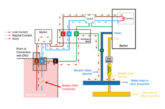
The experts at Phoenix Contact look at how the latest amendment to the Wiring Regulations is affecting the use and installation of surge protection.
In April of this year, Amendment 2 to the 18th Edition of BS7671 was published. BS7671 is technically not a legal document, but it does provide valuable guidance and information for anyone working on an electrical installation.
Such installations need to be designed and installed to the latest regulations to ensure the protection of persons, livestock and property, and it is this that is the main reason surge protection has become more important (and guidelines less vague) since the 18th Edition went live in January 2019. The two most important changes are:
• The removal of any requirement to carry out a risk assessment, effectively meaning the installation of SPDs can no longer be decided via a calculation.
• The removal of any exemption for single dwellings. They now also need to be considered along with all other electrical installations.
Chapter 443 deals with Protection against transient over-voltages of atmospheric origin or due to switching, and within this regulation 443.4.1 covers the different circumstances where protection against transient over-voltages is required.
In short, Amendment 2 now lists three shall be’s when considering if surge protection is required. It is stated: ‘Protection against transient over-voltages shall be provided where the consequence caused by over-voltage could result in:
i. Serious injury to, or loss of, human life,
ii. Failure of a safety service, as defined in Part 2,
iii. Significant financial or data loss.’
It is arguably the second point listed, relating to the protection of a safety service, that is the most significant change. BS7671 defines a safety service as:
‘An electrical system for electrical equipment provided to protect or warn persons in the event of a hazard, or essential for their evacuation from a location.’
Quite clearly this would affect all public buildings or installations where there is a safety system installed to protect people. That would include fire alarm systems, emergency lighting, gas detection systems, fire rescue service lifts, CCTV, public address (PA) or tannoy systems used in the event of an emergency evacuation. The kind of system is commonplace in hotels, airports, public transport, museums, libraries, schools and colleges, to name just a few. Such safety services have not been explicitly mentioned in the Wiring Regulations up until now, however.
Another important change can be found in Part 7 of BS7671 which deals with special installations or locations covering such installations as swimming pools, caravans, marinas, and solar PV. It is the last of these that is now included by Amendment 2.
Regulation 712.443.103 Protection against transient overvoltage, states: ‘Where protection against transient overvoltage is required by section 443, such protection shall also be applied to the DC side of the PV installation.’
In plain English, if the entire installation requires surge to be installed to comply with section 443 then it will be a requirement that SPDs are installed on the DC side of a PV array to protect the inverter and the PV panels.
Surge protection devices designed to be used to protect the DC side of a PV system are designed to a different standard to those that are for use in a low voltage installation and typically have nominal voltage ratings of 1,000 or 1,500 VDC.
Access Phoenix Contact’s surge protection selection guide here









